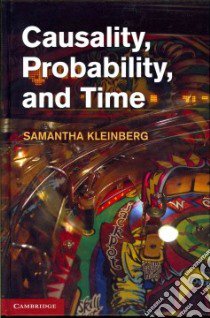- Libreria
- >
- Libri in lingua
- >
- Filosofia
- >
- Filosofia
Causality, Probability, and Time - 9781107026483
Un libro in lingua di Samantha Kleinberg edito da Cambridge Univ Pr, 2012
- € 125.70
- Il prezzo è variabile in funzione del cambio della valuta d’origine
"Whether we want to know the cause of a stock's price movements (in order to trade on this information), the key phrases that can alter public opinion of a candidate (in order to optimize a politician's speeches) or which genes work together to regulate a disease causing process (in order to intervene and disrupt it), many goals center on finding and using causes. Causes tell us not only that two phenomena are related, but how they are related. They allow us to make robust predictions about the future, explain the relationship between and occurrence of events, and develop effective policies for intervention. While predictions are often made successfully on the basis of associations alone, these relationships can be unstable. If we do not know why the resulting models work, we cannot predict when they will stop working. Lung cancer rates in an area may be correlated with match sales if many smokers use matches to light their cigarettes, but match sales may also be influenced by blackouts and seasonal trends (with many purchases around holidays or in winter). A spike in match sales due to a blackout will not result in the predicted spike in lung cancer rates, but without knowledge of the underlying causes we would not be able to anticipate that failure. Models based on associations can also lead to redundancies, since multiple effects of the true cause may be included as they are correlated with its occurrence. In applications to the biomedical domain, this can result in unnecessary diagnostic tests that may be invasive and expensive"--
Informazioni bibliografiche
- Titolo del Libro in lingua: Causality, Probability, and Time
- Lingua: English
- Autore: Samantha Kleinberg
- Editore: Cambridge Univ Pr
- Collana: Cambridge Univ Pr (Hardcover)
- Data di Pubblicazione: 11 Novembre '12
- Genere: COMPUTERS
- Argomenti : Computational complexity COMPUTERS / Natural Language Processing. bisacs
- Pagine: 259
- ISBN-10: 1107026482
- EAN-13: 9781107026483


